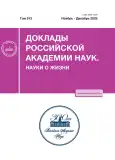CHROMATIN REMODELING COMPLEX PBAF ACTIVATES AND REPRESSES INFLAMMATORY GENES
- Авторлар: Feoktistov A.V.1,2, Georgieva S.G.1, Soshnikova N.V.1,2
-
Мекемелер:
- Engelhardt Institute of Molecular Biology, Russian Academy of Sciences
- Center for Precision Genome Editing and Genetic Technologies for Biomedicine, Engelhardt Institute of Molecular Biology, Russian Academy of Sciences
- Шығарылым: Том 513, № 1 (2023)
- Беттер: 590-594
- Бөлім: Articles
- URL: https://journals.rcsi.science/2686-7389/article/view/244397
- DOI: https://doi.org/10.31857/S2686738923600462
- EDN: https://elibrary.ru/GPQOZU
- ID: 244397
Дәйексөз келтіру
Толық мәтін
Аннотация
The PBAF chromatin remodeling complex regulates chromatin state and gene transcription in higher eukaryotes. In this work, we studied the role of PBAF in the regulation of NF–κB-and JAK/STAT-dependent activation of inflammatory genes. We performed knockdown of specific module subunit BAF200 resulted in destruction of the entire PBAF specific module and changed the level of the genes transcription of both pathways. PBAF can be both an activator and a repressor of inflammatory genes. Thus, PBAF is one of the important regulators of inflammatory gene expression.
Негізгі сөздер
Авторлар туралы
A. Feoktistov
Engelhardt Institute of Molecular Biology, Russian Academy of Sciences; Center for Precision Genome Editing and Genetic Technologies for Biomedicine, Engelhardt Institute of Molecular Biology, Russian Academy of Sciences
Хат алмасуға жауапты Автор.
Email: a.feo95@mail.ru
Russian Federation, Moscow; Russian Federation, Moscow
S. Georgieva
Engelhardt Institute of Molecular Biology, Russian Academy of Sciences
Email: a.feo95@mail.ru
Russian Federation, Moscow
N. Soshnikova
Engelhardt Institute of Molecular Biology, Russian Academy of Sciences; Center for Precision Genome Editing and Genetic Technologies for Biomedicine, Engelhardt Institute of Molecular Biology, Russian Academy of Sciences
Email: a.feo95@mail.ru
Russian Federation, Moscow; Russian Federation, Moscow
Әдебиет тізімі
- Yuan J. et al., Structure of human chromatin-remodelling PBAF complex bound to a nucleosome, // Nature, 2022. V. 605. P. 166–171.
- Centore R.C. et al., Mammalian SWI/SNF Chromatin Remodeling Complexes: Emerging Mechanisms and Therapeutic Strategies, // Trends in Genetics., 2020. V. 36. № 12. P. 936–950.
- Ishizaka A. et al., Double plant homeodomain (PHD) finger proteins DPF3a and -3b are required as transcriptional co-activators in SWI/SNF complex-dependent activation of NF-κB RelA/p50 heterodimer, // Journal of Biological Chemistry., 2012. V. 287. № 15. P. 11924–11933.
- Ramirez-Carrozzi V.R. et al., A unifying model for the selective regulation of inducible transcription by CpG islands and nucleosome remodeling // Cell., 2009. V. 138. № 1. P. 114–128.
- Gioacchino Natoli, NF-κB and chromatin: ten years on the path from basic mechanisms to candidate drugs // Immunological Reviews., 2012. V. 246. № 1. P. 183–192.
- Ramirez-Carrozzi V.R. et al., Selective and antagonistic functions of SWI/SNF and Mi-2β nucleosome remodeling complexes during an inflammatory response // Genes & Development., 2006. V. 20. P. 282–296.
- Chen M. et al., CDK8/19 Mediator kinases potentiate induction of transcription by NfκB // PNAS., 2017. V. 114. № 38. P. 10208–10213.
- Tatarskiy V.V. et al., Stability of the PHF10 subunit of PBAF signature module is regulated by phosphorylation: role of β-TrCP // Scientific Reports., 2017. V. 7. P. 5645.
- Brechalov A.V. et al., Mammalian cells contain two functionally distinct PBAF complexes incorporating different isoforms of PHF10 signature subunit // Cell Cycle., 2014. V. 13. № 12. P. 1970–1979.
- Soshnikova N.V. et al., PHF10 subunit of PBAF complex mediates transcriptional activation by MYC // Oncogene., 2021. V. 40. № 42. P. 6071–6080.
- Vorobyeva N.E. et al., Transcription coactivator SAYP combines chromatin remodeler Brahma and transcription initiation factor TFIID into a single supercomplex // PNAS., 2009. V. 106. № 27. P. 11049–11054.
- Min S. et al., Transcriptional regulation and chromatin dynamics at DNA double-strand breaks // Experimental & Molecular Medicine., 2022. V. 54. P. 1705–1712.
- Musladin S. et al., The RSC chromatin remodeling complex has a crucial role in the complete remodeler set for yeast PHO5 promoter opening // Nucleic Acids Research., 2014. V. 42. № 7. P. 4270–4282.












